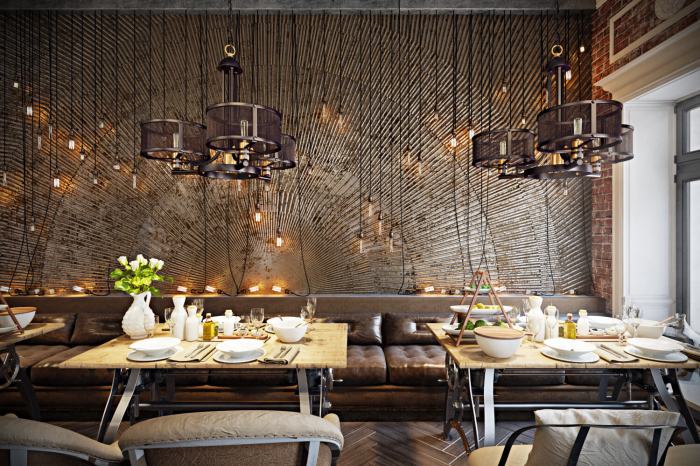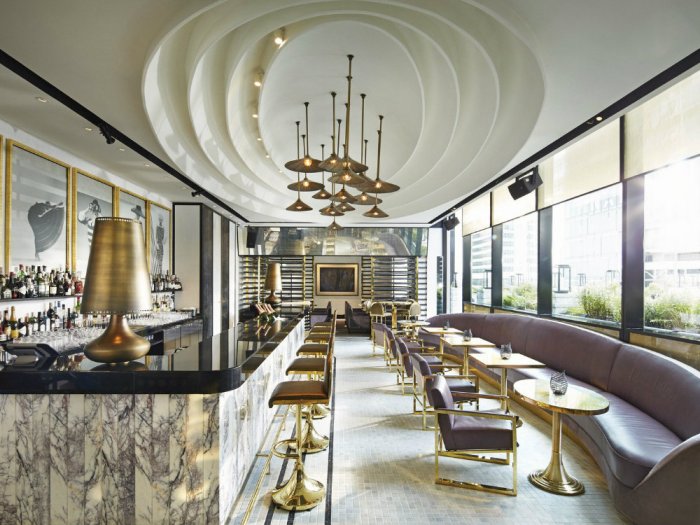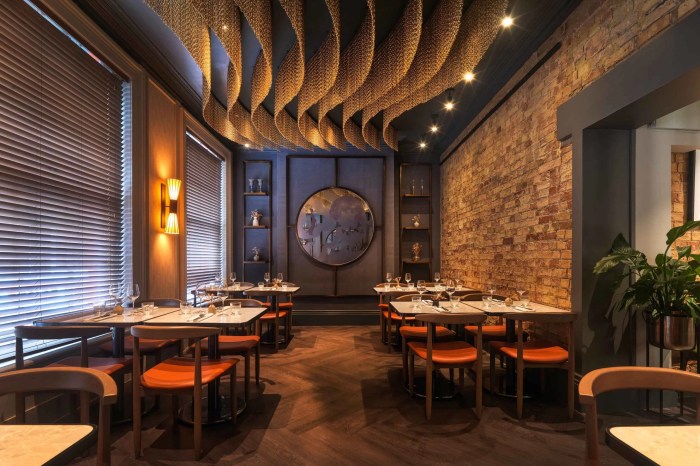Captivating Title: Elevating Customer Experience Through Innovative Restaurant Interior Design

Embark on a journey through the world of restaurant interior design, where creativity meets functionality to create unforgettable dining experiences. From sleek modern designs to cozy traditional aesthetics, discover how every element plays a crucial role in shaping the ambiance of a restaurant.
Delve deeper into the importance of interior design in establishing a restaurant's identity and setting the stage for an exceptional customer journey.
Importance of Restaurant Interior Design

Interior design plays a crucial role in the success of a restaurant, as it significantly impacts the overall dining experience of customers. A well-designed interior can create a welcoming atmosphere, enhance the restaurant's brand image, and ultimately influence customer satisfaction and loyalty.
Enhancing Customer Experience
- Successful restaurant interior designs, such as the cozy and rustic decor of a neighborhood cafe or the sleek and modern aesthetics of a fine dining establishment, can greatly enhance the overall dining experience for customers.
- Comfortable seating, pleasing lighting, and thoughtful decor elements all contribute to creating a memorable and enjoyable ambiance that keeps customers coming back.
- For example, the vibrant and colorful interior of a Mexican restaurant can transport diners to a festive fiesta, while the minimalist and elegant design of a sushi bar can evoke a sense of tranquility and sophistication.
Reflecting Brand and Concept
- Interior design can also serve as a powerful tool for reflecting the restaurant's brand identity and concept. Whether it's a casual burger joint with a retro diner theme or a trendy bistro with an industrial-chic aesthetic, the interior design sets the tone for the overall dining experience.
- Consistent branding through interior design elements, such as color schemes, furniture choices, and decorative accents, helps reinforce the restaurant's identity and communicate its unique personality to customers.
- By aligning the interior design with the restaurant's brand and concept, owners can create a cohesive and memorable dining environment that resonates with their target audience.
Elements of Effective Restaurant Interior Design
Creating a well-designed restaurant interior involves a combination of various key elements that work together to enhance the dining experience for customers. Balancing aesthetics with functionality is crucial in achieving a cohesive design that not only looks good but also serves its purpose effectively.
Let's explore the essential elements that contribute to effective restaurant interior design.
Lighting
Effective lighting can set the mood and ambiance of a restaurant. It is important to consider natural light, artificial lighting fixtures, and the placement of lights to create a warm and inviting atmosphere. Proper lighting can also highlight key design elements and enhance the overall dining experience.
Furniture
The choice of furniture plays a significant role in the overall design and comfort of a restaurant. It is essential to select furniture that is not only aesthetically pleasing but also functional and comfortable for customers. The arrangement of furniture should allow for easy flow of movement and create a welcoming environment.
Color Schemes
Color schemes can greatly impact the mood and perception of a restaurant. Choosing the right colors that complement the overall theme and branding of the restaurant is essential. Whether it's bold and vibrant colors or subtle and neutral tones, the color scheme should evoke the desired atmosphere and enhance the dining experience.
Layout
The layout of a restaurant is crucial in optimizing space and creating a seamless flow for both customers and staff. It is important to consider the placement of tables, seating areas, bar area, and service stations to ensure efficiency and comfort.
A well-thought-out layout can enhance the overall dining experience and contribute to the success of a restaurant.
Trends in Restaurant Interior Design

Restaurant interior design trends are constantly evolving to meet the changing preferences of customers and to create unique dining experiences. Let's explore some of the current trends shaping the restaurant industry.
Traditional vs. Modern Design Trends
Traditional restaurant interior design often focuses on warm colors, classic furniture, and cozy lighting to create a welcoming atmosphere. In contrast, modern design trends lean towards minimalist decor, sleek furniture, and innovative lighting concepts to achieve a contemporary look. Both styles have their own charm and appeal to different target audiences.
Influence of Technology
Technology plays a significant role in shaping restaurant interior design trends. From interactive menus displayed on digital screens to ambient lighting controlled through smart devices, technology has revolutionized the way restaurants create immersive dining environments. Integrating technology seamlessly into the design can enhance the overall dining experience for customers.
Sustainable Practices in Restaurant Interior Design
Creating a sustainable restaurant interior design is not only beneficial for the environment but also for the overall success of the business. By incorporating eco-friendly materials and practices, restaurants can reduce their carbon footprint and appeal to environmentally conscious customers.
Use of Recycled Materials
One example of sustainable design in restaurant interiors is the use of recycled materials. This can include furniture made from reclaimed wood, countertops made from recycled glass, or decor made from repurposed materials. By giving new life to old items, restaurants can reduce waste and minimize their impact on the environment.
Energy-Efficient Lighting
Another eco-friendly practice in restaurant interior design is the use of energy-efficient lighting. LED lights, for example, consume less energy than traditional bulbs and can significantly reduce electricity usage. Not only does this help the environment, but it also lowers operating costs for the restaurant.
Indoor Plants and Greenery
Incorporating indoor plants and greenery into the restaurant design not only adds a touch of nature but also improves indoor air quality. Plants help to purify the air by filtering out pollutants and releasing oxygen, creating a healthier environment for both customers and staff.
Final Summary

As we conclude our exploration of restaurant interior design, it becomes evident that the fusion of artistry and practicality is the key to crafting spaces that leave a lasting impression. Whether embracing sustainable practices or staying on top of the latest trends, the impact of interior design on the dining landscape is undeniable.
Frequently Asked Questions
How does interior design affect the overall dining experience?
Interior design sets the mood, influences customer perceptions, and plays a crucial role in creating a memorable dining experience.
What are some common elements of effective restaurant interior design?
Key elements include lighting, furniture selection, color schemes, and layout planning to create a cohesive and inviting space.
Why is sustainability important in restaurant interior design?
Sustainability showcases a commitment to environmental responsibility, attracts eco-conscious customers, and creates a positive brand image.

